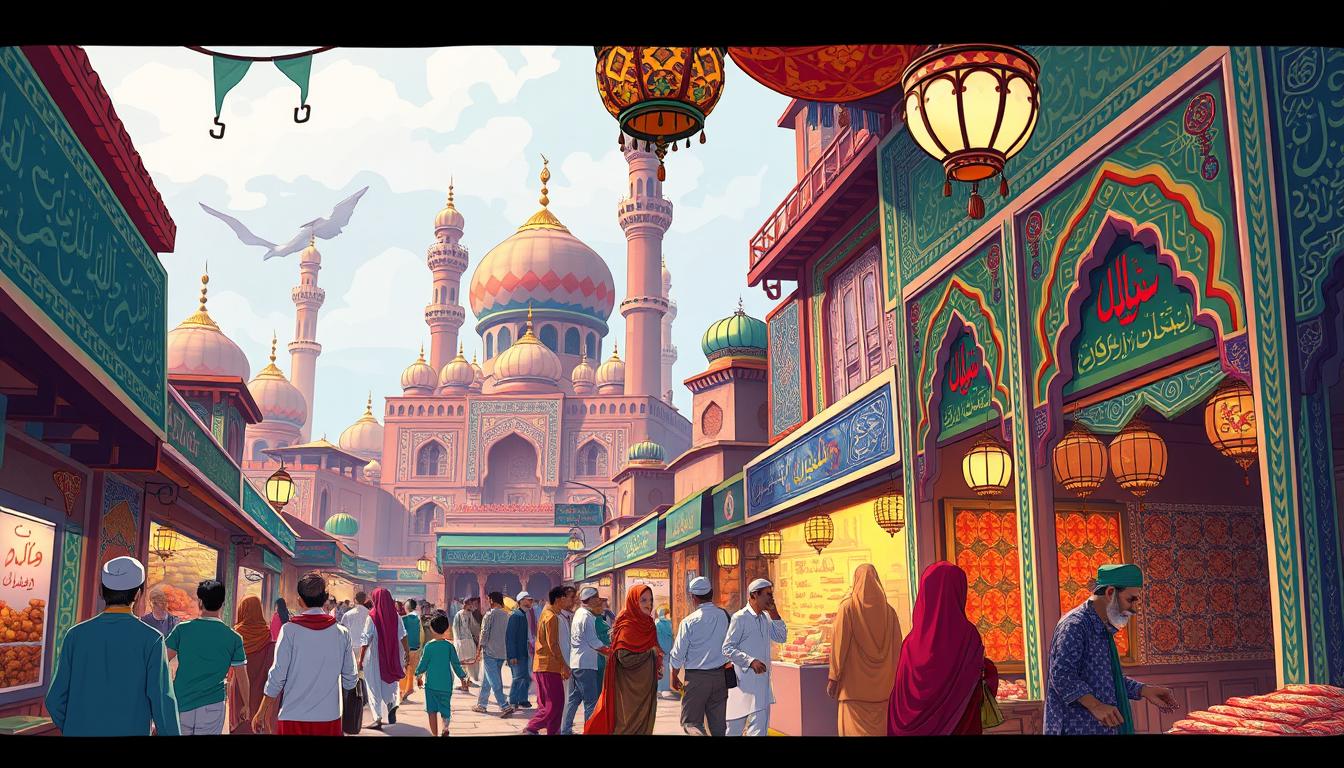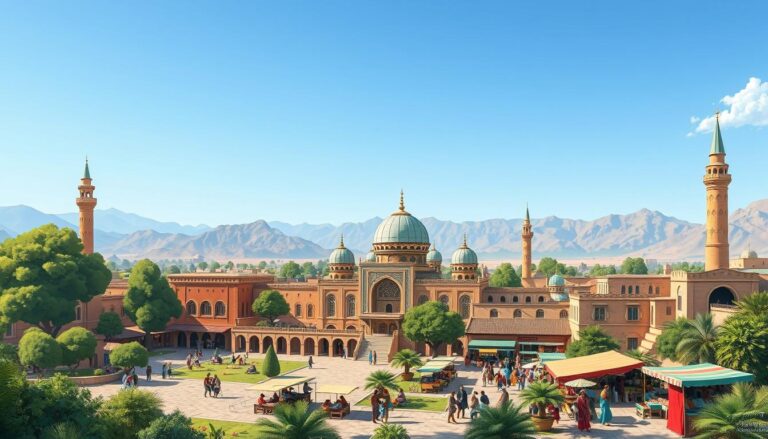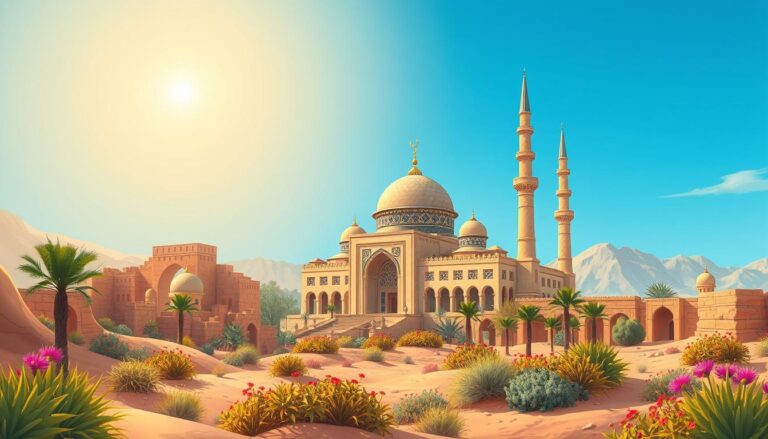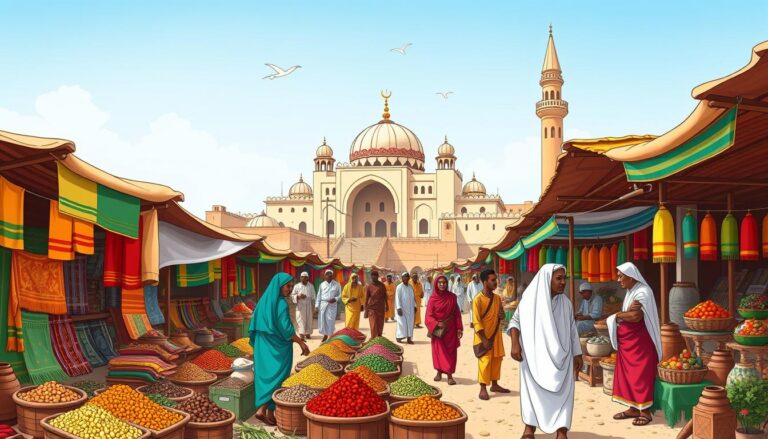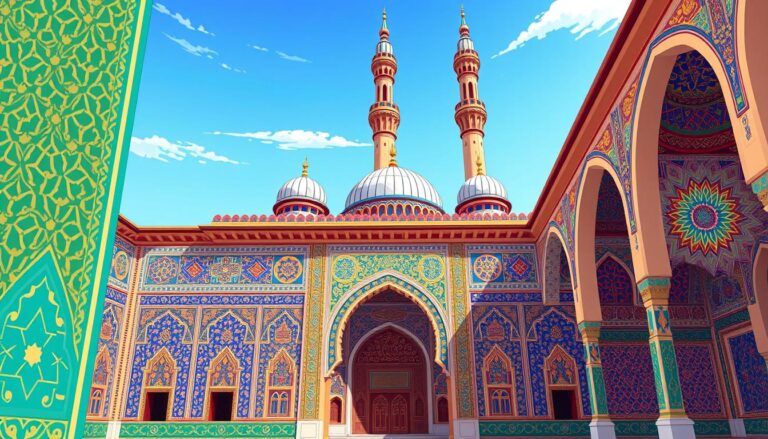Islam in Pakistan
Pakistan is home to over 236 million Muslims, making it the second-largest Muslim country after Indonesia. About 98% of the population follows Islam. The majority, around 90%, are Sunni Muslims. The remaining 10% are Shia Muslims.
Islam arrived in the Indus Valley in the 7th century with Arab conquerors. Over time, it deeply influenced the culture, politics, and society of Pakistan.
Islamic History and Influence in the Region
Islam arrived in the Indian subcontinent early, thanks to Baba Ratan Hindi, a trader from Punjab. He was a non-Arab companion of Prophet Muhammad. In the 7th century, the Rashidun caliphate conquered Makran after defeating Sindh in the Battle of Rasil.
Over time, Sufi missionaries helped convert many Buddhists and Hindus to Islam. This was a key moment in the region’s history.
Early Conquest and Spread of Islam
This led to the rule of Muslim empires like the Ghaznavid, Ghorid, and Delhi Sultanate. These conquests and settlements set the stage for the Mughal Empire. It ruled from 1526 to 1857.
Mughal Empire and Islamic Rule
The Mughal Empire, founded by Babur, was a significant Islamic dynasty. It greatly influenced the Indian subcontinent. During their rule, the Mughals promoted Islamic culture and architecture.
“Islam in Pakistan discusses the pivotal role facets of Islam have played in Pakistani history.”
The Islamic history in Pakistan is deeply rooted in Islamic conquest, Arab settlement, and Islamic rule. The Mughal Empire’s dominance had a lasting impact. It shaped the region’s culture, society, and identity.
Sunni Islam in Pakistan
About 90% of Pakistani Muslims follow Sunni Islam. The Hanafi school is the main sect, known for being the most liberal. This school has greatly influenced Pakistan’s culture and religion for centuries.
Two important reform movements also exist in Pakistan: the Barelvi and Deobandi traditions. These sects have different beliefs, leading to tensions and sometimes violence between their followers.
Barelvi and Deobandi Traditions
The Barelvi tradition, started by Ahmad Raza Khan Barelvi in the late 19th century, focuses on honoring saints and mysticism. It also believes in the Prophet Muhammad’s spiritual presence. On the other hand, the Deobandi movement, founded in India in the 1860s, is more strict. It emphasizes following Sharia law and rejects some Sufi practices.
These different beliefs have caused divisions within Sunni Islam in Pakistan. Yet, the majority of Pakistanis still follow the Hanafi school. This school continues to define the religious and cultural identity of most Pakistanis.
Shia Islam in Pakistan
In Pakistan, most Muslims are Sunni, but Shia Muslims make up about 10-15% of the total. The Shia community includes different groups like Ismailis and Ithnā ‘Ashariyyah. These groups share similarities with Shia traditions in Iran.
The Shia minority in Pakistan has faced many challenges. Between 1999 and 2003, about 600 Shia were killed in extremist attacks. In 2013, around 700 Shia were murdered in targeted attacks across the country.
The Hazara community, a Shia ethnic group, has been especially hit hard. At least 509 Hazaras were killed and 627 injured in Quetta over the last five years. These attacks were carried out by extremist groups.
“The Shia-Sunni conflict in Pakistan is noted to be increasingly virulent due to the state’s failure to combat Sunni extremism.”
The Hazara community in Quetta is now limited to two areas, Hazara Town and Alamdar Road. Shia Islam in Pakistan faces big challenges, like the rise of Sunni extremism and the state’s inability to stop it.
Despite these challenges, the Shia minority in Pakistan keeps its cultural and religious identity. They are the second-largest Shia community after Iran. Their history and traditions are a big part of Pakistan’s Islamic heritage.
Sufism and Spiritual Traditions
Sufism, the mystical branch of Islam, is deeply rooted in Pakistani society. People in Pakistan honor Sufi saints, called “pirs.” These pirs are seen as holy men, guiding their followers spiritually.
Sufi orders like the Naqshbandiyya, Chishtiyya, and Qadiriyya have shaped Pakistan’s religious scene. About 60% of Muslims in Pakistan follow Sufi saints. This shows how big Sufism’s impact is in the region.
Role of Pirs and Sufi Orders
Sufis believed in pirs, or “spiritual guides,” who had special connections to Allah. Sufism focused on mystical experiences and the Quran’s poetic side. It was different from the teachings of mullahs.
Some political Islamist groups in Pakistan started from Sufi orders. This shows the complex ties between Sufism and Pakistan’s religious scene. Sufis fight against Islamic extremism but face violence too, like attacks on shrines and killings.
“Sufism did not preach Islam in the same way as mullahs did, focusing more on mystical experiences and the poetic aspects of the Quran.”
Despite hardliner attacks, mystic piety is still a big part of Pakistani religion. Sufi poetry, music, and dance are attacked by extremists. But, the power of pirs and Sufi orders keeps shaping Pakistan’s spiritual world.
Islam in Pakistan
Islam is the main religion in Pakistan, with almost 98% of people calling themselves Muslim. The country’s Islamic roots are deep, seen in its history and culture. Islamic values and practices are everywhere, from mosques to holidays and institutions.
When Pakistan was formed in 1947, it was the biggest Muslim country. Today, it’s the second-largest, after Indonesia. South Asia, including Pakistan, has seen efforts to rethink Islamic texts and traditions since the late 1800s. This has led to debates about Islam’s role in public life.
The 2017 census showed Sunnis make up 80-85% of Muslims in Pakistan. Shia Muslims, including Hazara, Ismaili, and Bohra, are 15-20%. Minorities, like Hindus, Christians, and Sikhs, make up 3-5% of the population.
“Pakistan has been a site of intense contestation over Islam’s public place, meaning, and interpretation.”
– Muhammad Qasim Zaman, author of “Islam in Pakistan”
Zaman’s book “Islam in Pakistan” is a Choice Outstanding Academic Title. It explores Islam’s growth in Pakistan over 150 years. The book dives into key aspects of Islam in Pakistani history, shedding light on what an Islamic state is.
Islam was key in Pakistan’s fight for independence. It remains crucial in the country’s politics today. Different groups, like Islamists and political parties, have their own views on religion and the state. This has shaped Pakistan’s politics and how it treats religious minorities.
Islamic Movements and Organizations
Pakistan is a key place for Islamic movements and groups. These have greatly influenced the country’s religious and political scenes. The Jamaat-e-Islami and Tablighi Jamaat are two big names. They work hard to spread Islamic values and connect with people at the grassroots level.
Jamaat-e-Islami and Islamic Revival
The Jamaat-e-Islami was started by Abul A’la Maududi. It fights for an Islamic state in Pakistan. The group wants the country to follow Islamic rules in all areas of life.
When General Muhammad Zia-ul-Haq was in power from 1977 to 1988, the group’s ideas got more support. This led to Sharia law being applied and Islamic teachings being added to the legal system.
Tablighi Jamaat and Grassroots Outreach
The Tablighi Jamaat is another big Islamic movement in Pakistan. It’s a group that focuses on changing people’s lives through religious teachings. They aim to make people more devoted to Islam.
This group has attracted many followers in Pakistan and around the world. Their message of personal faith and community improvement has touched many lives. It has helped change Pakistan’s religious and social scene.
“The Islamization program initiated by Zia-ul-Haq received 97.7% approval in a 1984 referendum, but protests against the laws occurred.”
The rise of these Islamic movements has changed Pakistan a lot. There are ongoing debates about the role of religion in government and the rights of minorities. As Pakistan tries to balance secular and religious values, these groups will keep playing a big role in its future.
Sectarian Tensions and Extremism
Pakistan faces big sectarian tensions, mainly between Sunni and Shia Muslims. There have been violent clashes and attacks on Shia minorities. These issues stem from deep theological differences and the growth of extremist groups.
Sunni-Shia Conflicts
Shias make up less than 15 percent of the world’s Muslims but 15 to 25 percent in Pakistan. This divide has caused long-standing conflicts. From 1989 to 2004, sectarian violence killed 688 people in 1,837 incidents.
Rise of Extremist Groups
Groups like Lashkar-e-Jhangvi and Sipah-e-Sahaba lead anti-Shia violence. Wahhabi influence from Saudi Arabia and radical Sunni groups have worsened tensions. This has led to more Islamic extremist movements in Pakistan.
“Sectarian attacks in the 1980s and 1990s killed thousands in Pakistan.”
The Pakistani state has mainly used force against sectarian militancy. It needs a more active approach, like better intelligence and prosecuting those who stir up violence.
Sunni Islamist groups, including Barelvi sub-sects, also fuel violence. The rise of ISKP and the Barelvi movement Labaik has made things worse. They’ve attacked Shia mosques and communities, causing great harm.
Islamic Education and Madrasas
In Pakistan, Islamic education is key, with madrasas at its heart. These schools teach Islamic theology, jurisprudence, and Arabic. They often stick to strict or extremist views of Islam.
Madrasas help many poor students who can’t go to private schools. Students of all ages can join. But, madrasas face big problems like no set curriculum, untrained teachers, and missing tools.
There are plans to update madrasa education. They want to add subjects like languages, literature, and tech. The Literate Pakistan Foundation (LPF) even offers a quick Islamic education course and free video lessons for madrasa students.
But, the madrasa system gets a lot of criticism. About 10-15% of madrasas teach extremist views, including violence and jihad. This has hurt Pakistan’s security, with madrasa students involved in conflicts worldwide.
“The system of madrasa education in Pakistan has seen significant growth and influence over the past two decades, with the government struggling to regulate and reform these institutions.”
The rise of madrasas, especially after the Soviet invasion of Afghanistan, worries many. The Pakistani government’s efforts to fix this issue haven’t worked well. The country spends only 2% of its national income on public education. This makes the madrasa system even more important, but also makes quality education and religious balance hard to achieve.
Islam and Pakistani Politics
The role of Islam in Pakistani politics is a topic of debate. Since Pakistan started in 1947, Islam has been key in forming a national identity. This was shown in the Objectives Resolution of 1949, which said God has sovereignty over the universe.
Objectives Resolution and Islamic Ideals
The Objectives Resolution highlighted the role of religion in the state. Islamic movements like the Jamaat-e-Islami push for Sharia law and Islamic systems. But, the Jamaat-e-Islami has found it hard to get many votes in elections.
Since Pakistan began, there’s been a fight between secular and Islamic views. Military rule from 1977-1988 made Pakistan more Islamic. This included new laws, compulsory Islamic education, and support for religious schools.
This support from the military and religious groups, backed by the U.S. and Saudi Arabia, helped create a jihadist network. This network affected Pakistan and the world for many years.
Even though the Jamaat-e-Islami hasn’t done well in elections, Islam in Pakistani politics is still important. The Objectives Resolution and the push for Islamic ideals are central to this debate.
“Since Pakistan’s inception in 1947, Islam has been the primary basis for creating a national identity in a country divided along ethnic, provincial, and religious lines.”
Conclusion
The story of Islam in Pakistan is complex and rich. It spans the country’s history, culture, and politics. The faith spread early and has diverse sects and movements.
Despite sectarian tensions and extremism, most Pakistanis hold their Islamic faith dear. Islam is a big part of their lives.
As Pakistan faces modern challenges, Islam’s role will stay key. This article has shown how Islam shapes the nation. It highlights the faith’s lasting impact on Pakistan’s past, present, and future.
The 1945-46 elections showed the Muslim League’s role in representing India’s Muslims. The Objectives Resolution of 1949 set the stage for Pakistan’s constitution. These moments show Islam’s impact on Pakistan’s politics.
The army’s early support for jihad and debates over Ahmadis’ status add to the complexity. This shows how religion and power mix in Pakistan.
Source Links
- Pakistan – Islam, Hinduism, Sikhism
- Islam in Pakistan
- Islam in Pakistan
- Islam in South Asia – Association for Asian Studies
- Religion in Pakistan
- FRONTLINE/WORLD . Pakistan – On a Razor’s Edge . Facts
- Pakistani – Religion
- Shi’a and Hazaras in Pakistan – Minority Rights Group
- The Shias of Pakistan | Hurst Publishers
- Pakistani Shias live in terror as sectarian violence increases
- Sufism in Pakistan
- Pakistan’s Sufis Preach Faith and Ecstasy
- Islam in Pakistan : The land of the Sufis | Qantara.de
- Islam in Pakistan
- RRfinalMay04.qxd
- Pakistan – United States Department of State
- Islamization in Pakistan
- How to Islamize an Islamic Republic: Jamaat-e-Islami in its own words
- "Weeding Out the Heretics": Sectarianism in Pakistan
- Microsoft Word – 327 Pakistan – Sectarian Violence – Print.docx
- Sectarian violence in Pakistan
- Islamic Education | Madrasa Education in Pakistan 2023
- Pakistan’s Madrassahs: Ensuring a System of Education not Jihad
- The Role of Islamic Parties in Pakistani Politics
- Islam and Politics in Pakistan
- Islam and the Early History of Pakistan
- Conclusion: The Islamization Period in the Balance

